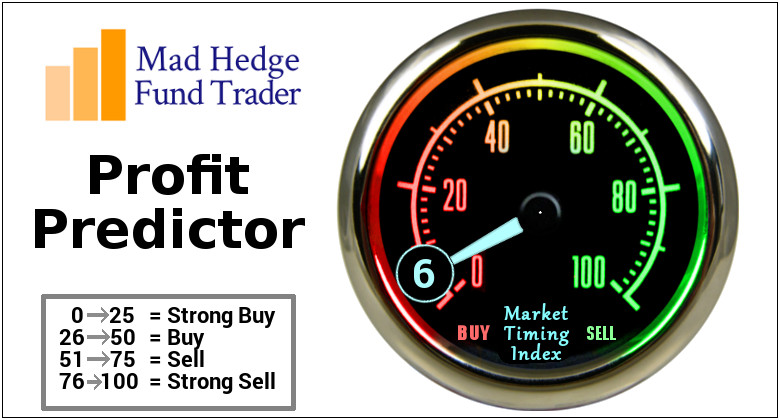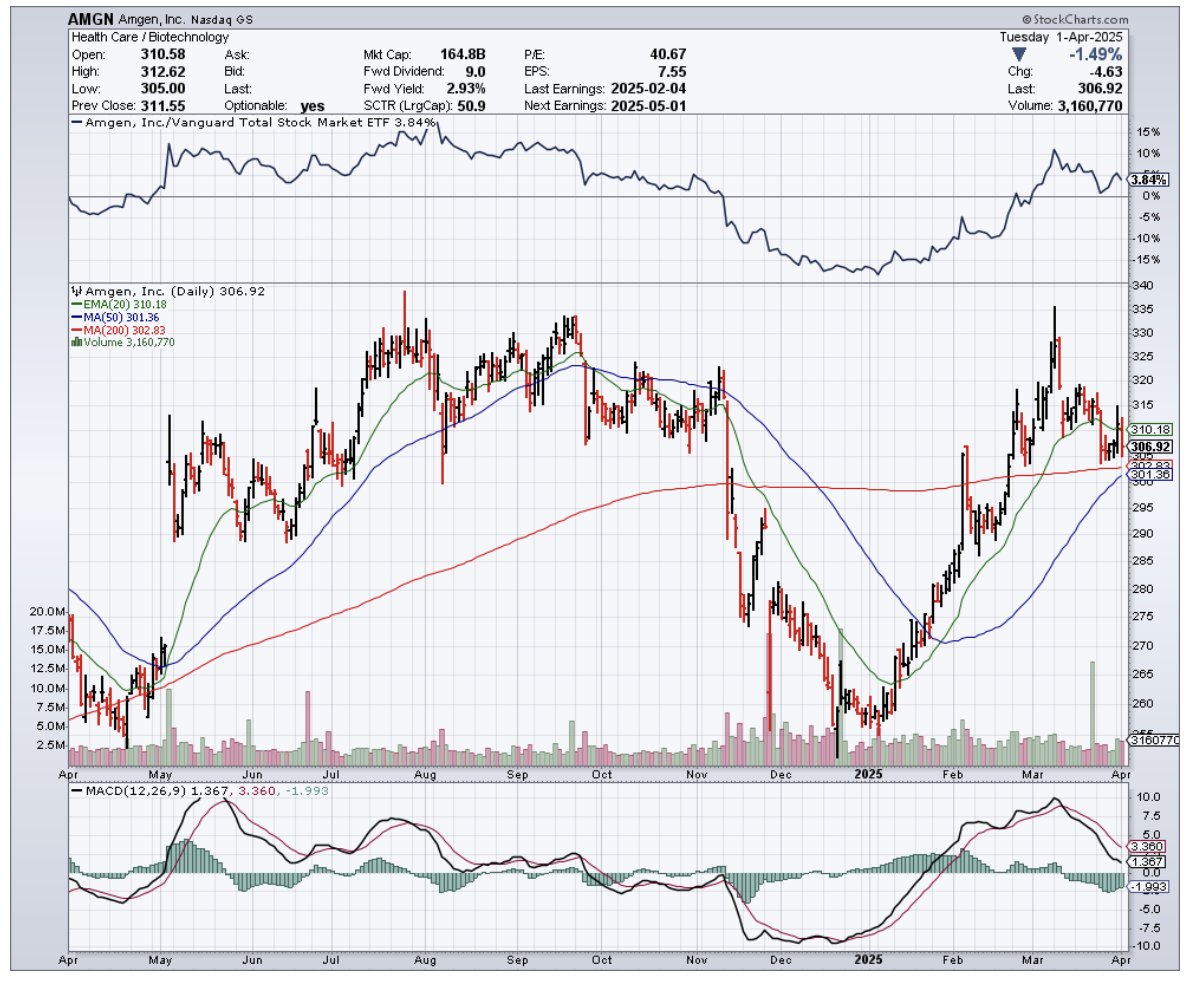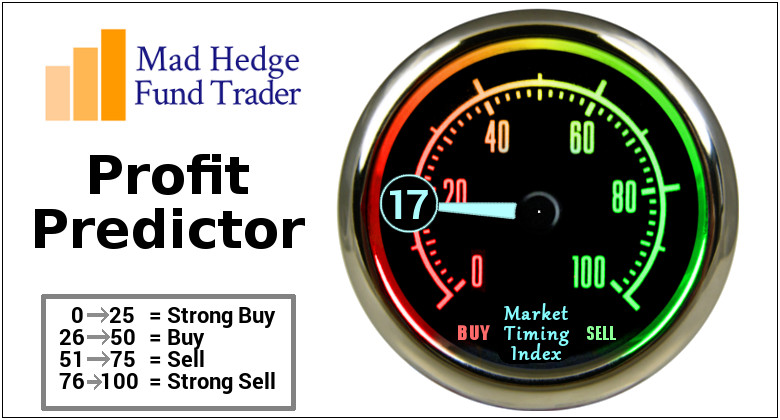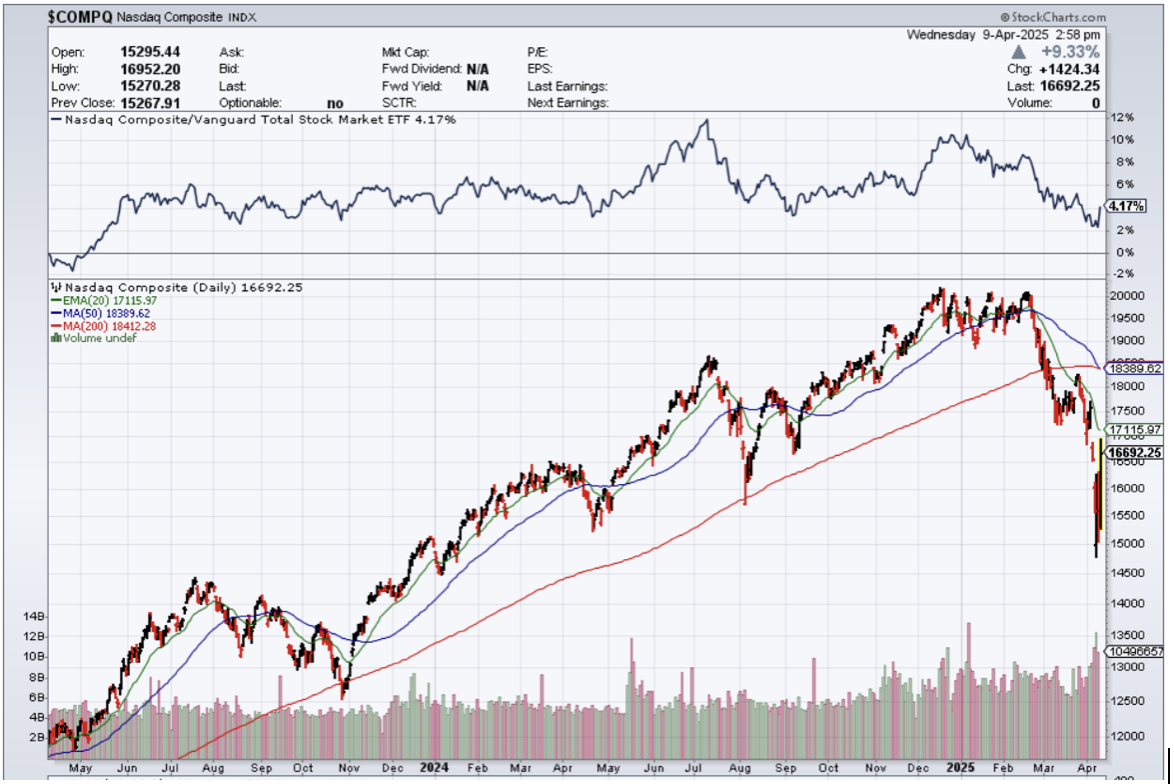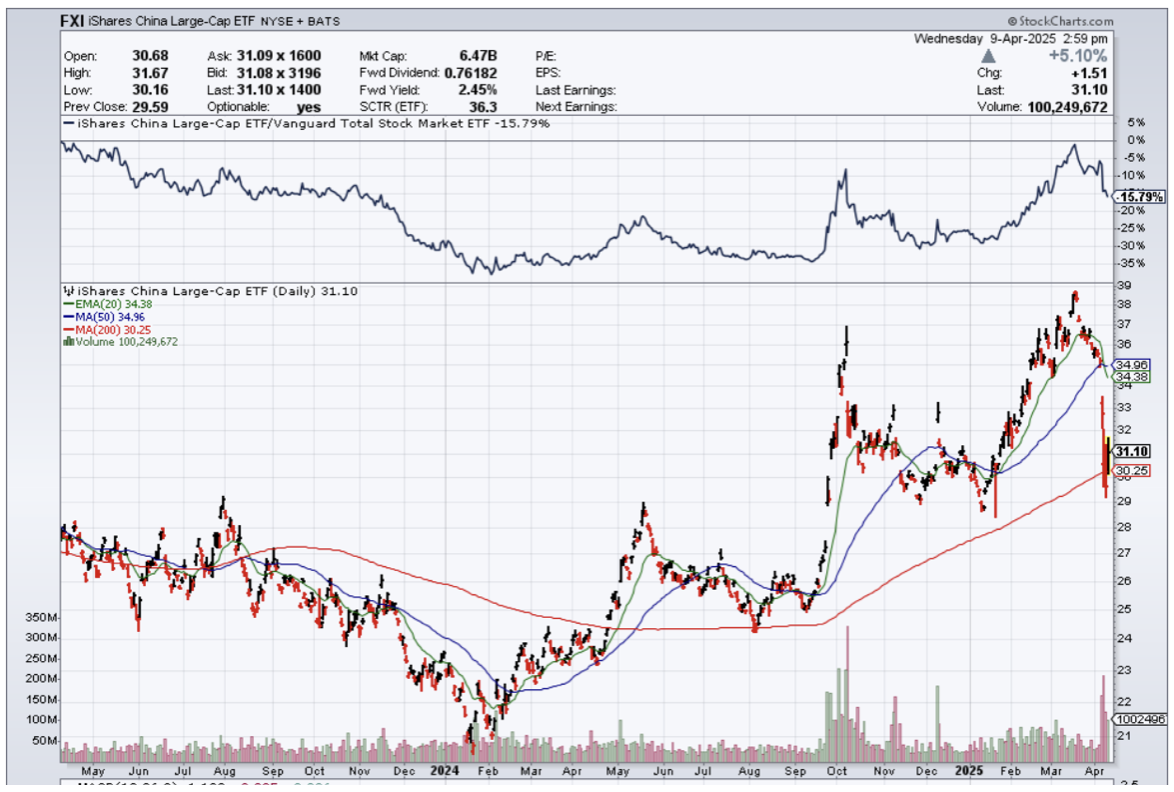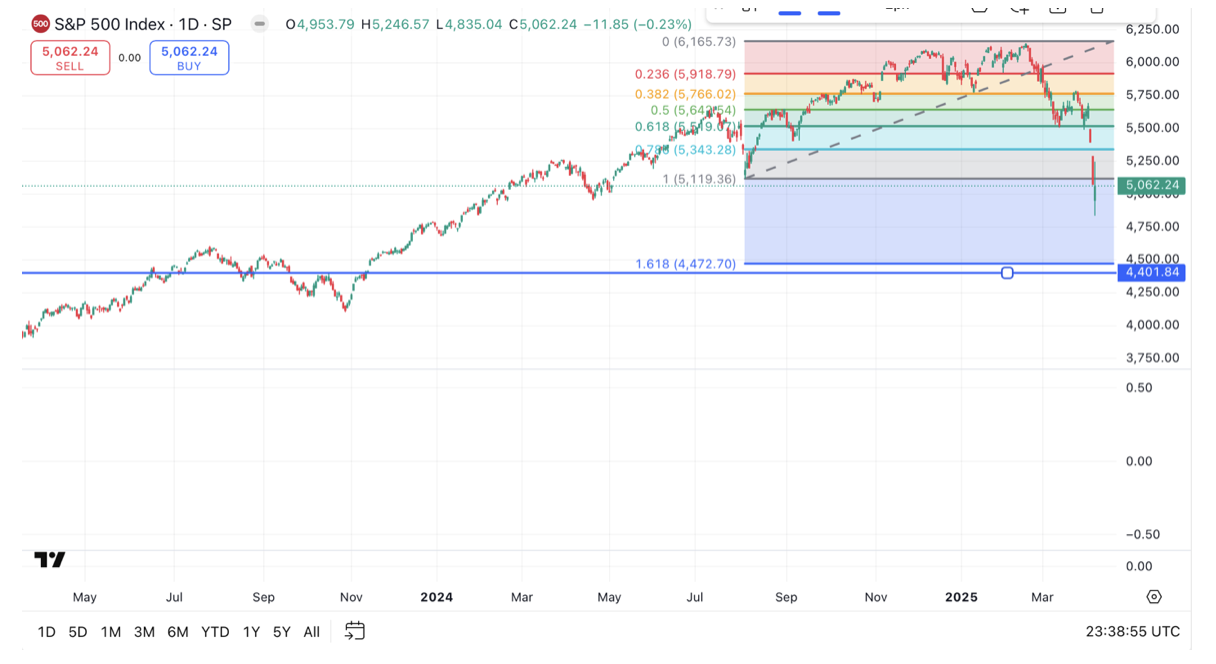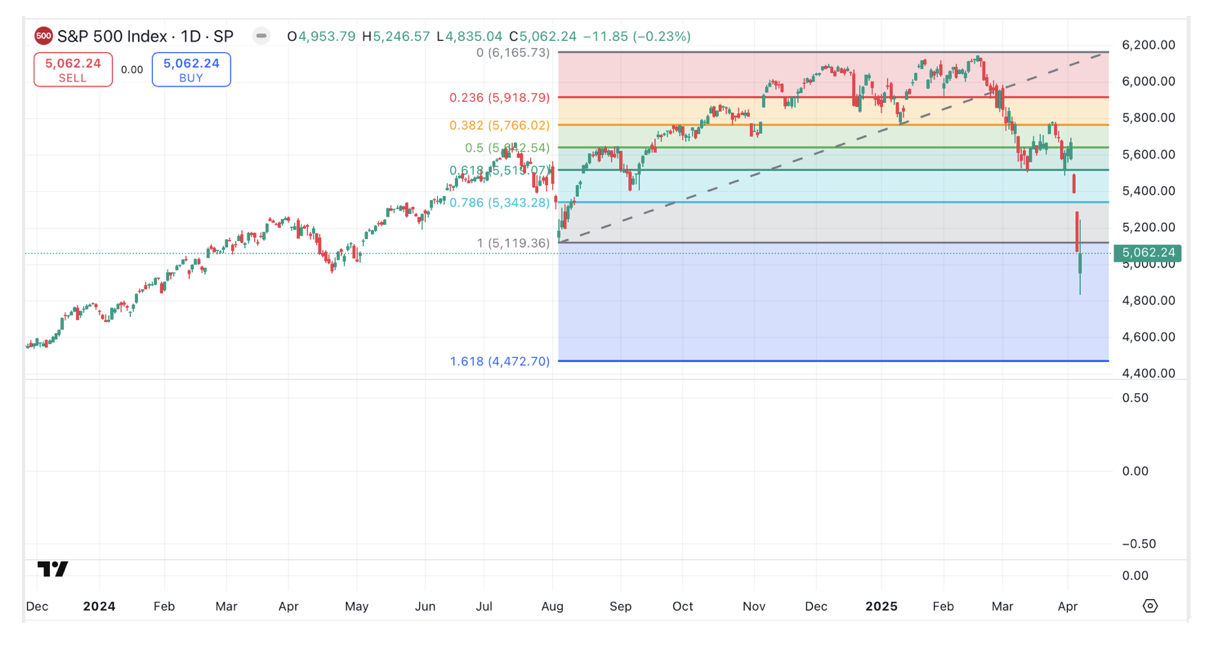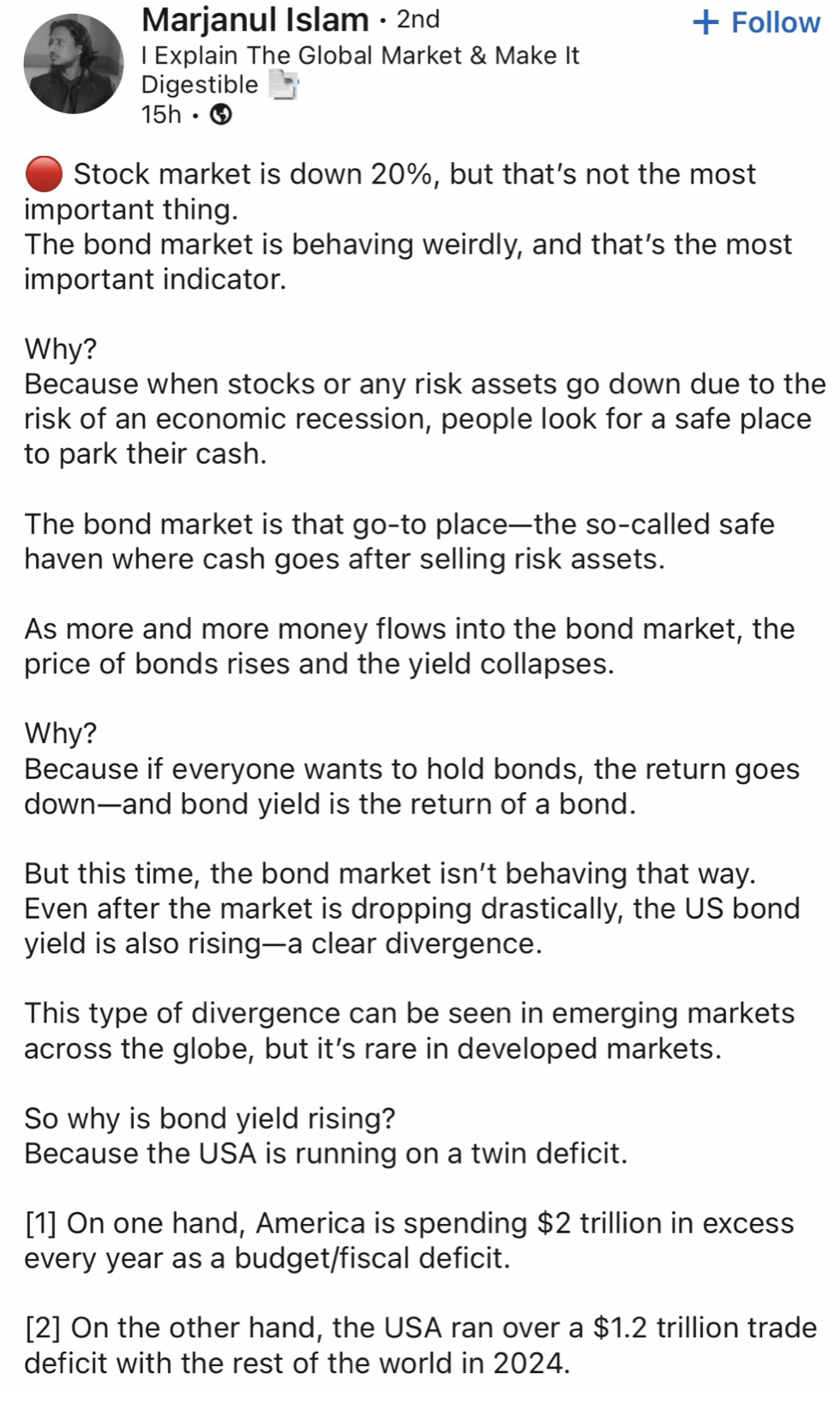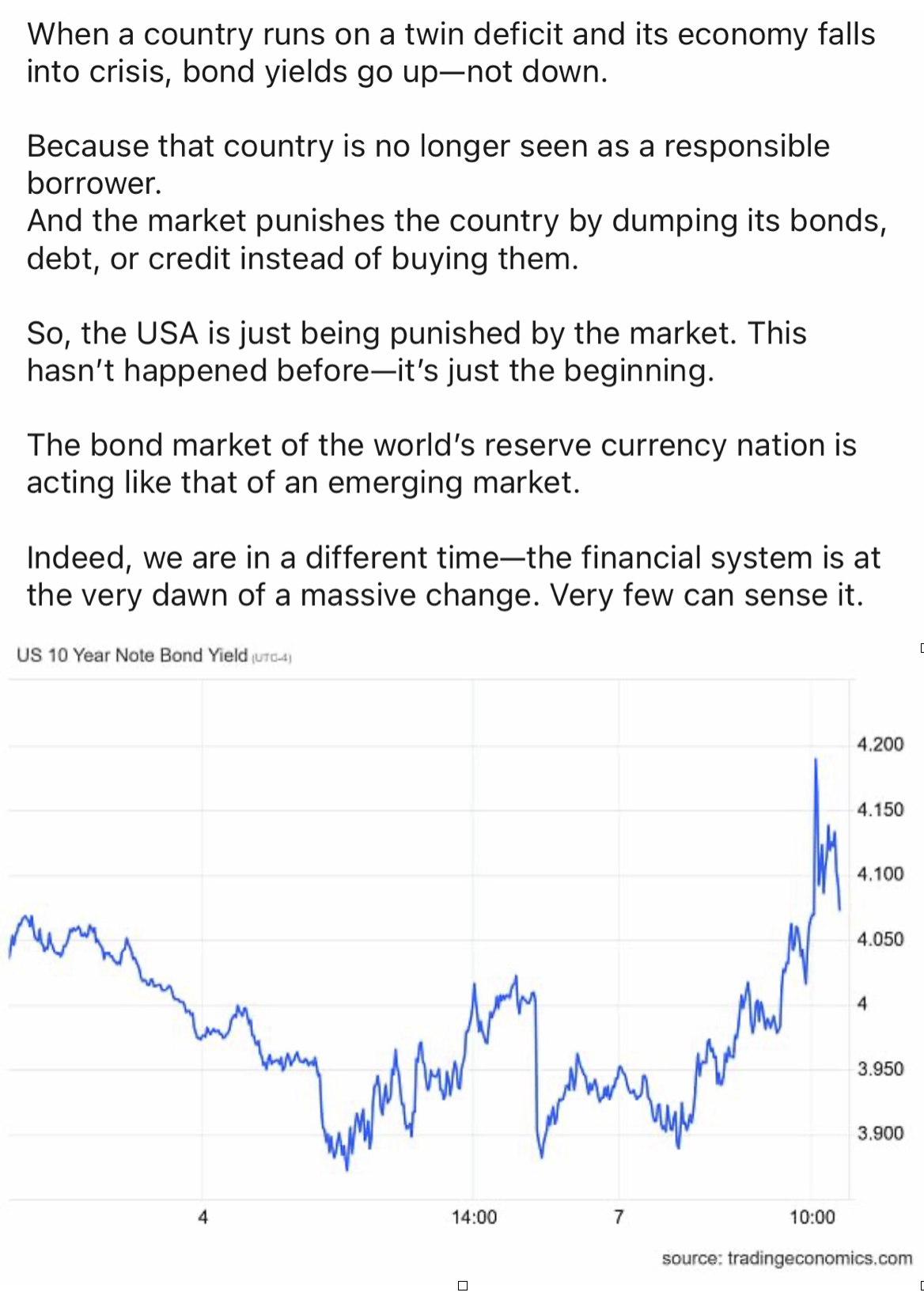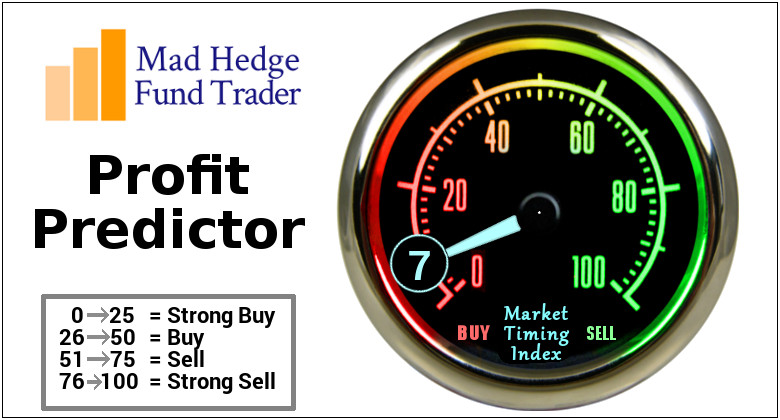When John identifies a strategic exit point, he will send you an alert with specific trade information as to what security to sell, when to sell it, and at what price. Most often, it will be to TAKE PROFITS, but, on rare occasions, it will be to exercise a STOP LOSS at a predetermined price to adhere to strict risk management discipline. Read more
Mad Hedge Biotech and Healthcare Letter
April 10, 2025
Fiat Lux
Featured Trade:
(THE $5 BILLION SECRET I SPOTTED IN MY DOCTOR'S WAITING ROOM)
(AMGN), (NVO), (LLY), (MRK), (REGN)
Last Tuesday, my orthopedist kept me waiting 40 minutes past my appointment time – just long enough for me to witness what Wall Street's finest analysts have somehow managed to miss.
As I sat thumbing through a dog-eared copy of Golf Digest from 2018, I counted eight different patients called in for Prolia injections.
By the sixth one, I'd put down the magazine and started taking notes on my phone. By the eighth, I was already mentally calculating position sizes for my portfolio.
"You know what you just saw?" my doctor asked when he finally saw me. "That's Amgen's cash cow – $5.4 billion in sales last year for a twice-yearly injection. And guess what? Half these patients will be on it for life."
When I pressed him on competing drugs, he just laughed. "Their sales reps bring the best lunches. But seriously, it works, patients tolerate it, and insurance covers it. In medicine, that's the holy trinity."
While half of Wall Street hyperventilates about which pharmaceutical giant will dominate the weight loss market, and the other half chases whatever shiny tech story came out this morning, they're all missing Amgen (AMGN) – a money-printing machine trading at just 14.9 times earnings with a 3.1% dividend that grows like clockwork.
I've been investing in pharmaceutical companies since I covered Merck's (MRK) explosive growth for The Economist in the late 1970s, and one lesson has remained constant: the market consistently underestimates companies with proven track records during transitions.
Amgen, trading at $307, is a textbook example of this phenomenon right now.
The headline numbers don't initially spark excitement – management is guiding for modest 5% revenue growth and 4% EPS growth this year. But having analyzed hundreds of pharma companies over five decades, I know these conservative guidance figures are often the prelude to significant outperformance.
What matters more is their $5.9 billion R&D investment last year (up 25% from 2023) and the underappreciated potential of their pipeline.
Look beyond the surface, and you'll find Amgen has quietly built something remarkable. While everyone's fixated on Novo Nordisk’s (NVO) Ozempic and Wegovy, few have noticed that Amgen's existing product portfolio is delivering solid results.
Inflammation drug TEZSPIRE grew 71% year-over-year and is approaching the $1 billion annual sales milestone. Oncology drug BLINCYTO jumped 41%, and their cholesterol drug Repatha, combined with bone health treatment EVENITY, delivered $1 billion in year-over-year growth.
The real hidden value lies in Amgen's obesity program. The anti-obesity market that barely existed a few years ago has exploded to $2.2 billion and is projected to grow at 30% annually through 2030.
Eli Lilly (LLY) and Novo Nordisk have seen their market caps soar into the stratosphere on the strength of their GLP-1 drugs, but Amgen's market valuation doesn't reflect any meaningful potential from MariTide, their Phase 3 obesity candidate.
This reminds me of 2012 when I began accumulating Regeneron (REGN) while the market was completely missing the potential of Eylea. That position delivered a 580% return over the following three years.
What's particularly attractive about Amgen is the margin of safety it offers. With a 3.1% dividend yield (backed by a manageable 45% payout ratio and 13 consecutive years of growth), a forward P/E of just 14.9, and a fortress-like 46.3% operating margin, you're being paid to wait for the pipeline to deliver.
The company has been aggressively paying down the debt from its Horizon Therapeutics acquisition, reducing long-term obligations by $6.6 billion last year alone.
Their financial discipline stands in stark contrast to many of the speculative biotech plays I've been pitched recently. At a dinner with venture capitalists in Boston last week, I listened to presentation after presentation about pre-clinical assets with billion-dollar valuations and no revenue in sight.
Meanwhile, Amgen generated $33.4 billion in sales last year with industry-leading EBITDA margins of 45%.
Of course, there are risks. The upcoming patent expiration of osteoporosis drug Prolia this year creates a revenue gap that needs filling.
The Trump administration's Department of Government Efficiency (DOGE) initiative could potentially impact FDA testing labs, slowing approval timelines. But these concerns are already priced into the stock, while the potential upside from MariTide and other late-stage candidates is not.
Having navigated multiple market cycles since the 1970s, I've learned that the best investments often come when solid companies are temporarily overlooked during market rotations. Amgen remains a proven pharmaceutical innovator with strong cash flows, growing dividends, and a promising pipeline that offers compelling value.
I started building a substantial position in Amgen at around $260 during the post-election pharmaceutical sell-off and have continued to accumulate shares on weakness.
With a reasonable valuation, strong pipeline optionality, and dividend income that beats 10-year Treasury yields, Amgen represents the kind of steady compounder that has consistently outperformed over full market cycles.
In my decades of investing, I've found that buying excellent businesses during periods of unwarranted pessimism is the closest thing to a guaranteed winning formula.
With Amgen, you're essentially being paid a 3.1% annual dividend to own a company that could deliver a major surprise in the obesity market – the same market that transformed Novo Nordisk and Eli Lilly into two of the world's most valuable companies.
Sometimes the smartest investments are like colonoscopies – nobody's excited to talk about them at parties, but they'll save your financial health in the long run.
In today's rapidly evolving economic landscape, finance chiefs are under constant pressure to optimize spending, enhance efficiency, and drive profitability. A powerful weapon in their arsenal is digitalization, the integration of digital technologies into all areas of a business, fundamentally changing how it operates and delivers value. This transformation is no longer a futuristic concept but a present-day imperative for finance functions aiming to not only survive but thrive.
Recent surveys underscore the profound impact of digitalization, particularly through technologies like Artificial Intelligence (AI). A staggering 94% of finance leaders acknowledge that AI has already improved their decision-making capabilities. Even more compelling is the fact that 74% report tangible positive effects on both cost and risk reduction. These figures highlight a significant shift in the perception and adoption of digital tools within finance, moving from experimental phases to recognized drivers of tangible benefits.
This article delves into the multifaceted ways in which finance chiefs are leveraging digitalization to aggressively cut costs, enhance operational efficiency, and ultimately contribute more strategically to the overall success of their organizations. We will explore the key technologies being adopted, the specific areas within finance where these technologies are making the most significant impact, and the strategic considerations necessary for a successful digital transformation journey.
The Digital Revolution in Finance: A Multi-Pronged Approach to Cost Reduction
Digitalization in finance is not a monolithic endeavor. It encompasses a wide array of technologies and applications, each contributing to cost reduction in unique yet often interconnected ways. Finance chiefs are strategically deploying these tools across various functions, creating a synergistic effect that drives down expenses and improves overall performance.
- Automation of Routine Tasks: Freeing Up Human Capital
One of the most immediate and significant cost-saving benefits of digitalization is the automation of repetitive, manual tasks. Technologies like Robotic Process Automation (RPA) are being widely adopted to handle high-volume, rule-based activities such as data entry, invoice processing, account reconciliation, and report generation.
- Reduced Labor Costs: By automating these tasks, organizations can significantly reduce the need for manual labor, leading to lower salary expenses and overhead costs associated with a large workforce. For instance, automating invoice processing can drastically cut the time and personnel required to handle vendor payments.
- Improved Accuracy and Reduced Errors: Human error is an inherent risk in manual processes. Automation eliminates this risk, leading to more accurate data and fewer costly mistakes that require time and resources to rectify. Accurate financial records are crucial for informed decision-making and regulatory compliance, further preventing potential financial penalties.
- Increased Efficiency and Faster Turnaround Times: Automated processes can operate 24/7, significantly reducing turnaround times for critical financial operations. This speed and efficiency can lead to better cash flow management, improved vendor relationships through timely payments, and faster closing of financial periods.
- Reallocation of Human Resources: By freeing up finance professionals from mundane tasks, organizations can redeploy their talent to higher-value activities such as strategic analysis, forecasting, risk management, and business partnering. This shift maximizes the utilization of human capital and enhances the overall strategic contribution of the finance function.
- Artificial Intelligence and Machine Learning: Intelligent Cost Optimization
Beyond basic automation, Artificial Intelligence (AI) and Machine Learning (ML) are enabling finance chiefs to achieve more sophisticated levels of cost reduction through intelligent insights and predictive capabilities.
- Enhanced Forecasting and Budgeting: AI/ML algorithms can analyze vast datasets, including historical financial data, market trends, and macroeconomic indicators, to generate more accurate financial forecasts and budgets. This allows for proactive cost management by identifying potential overspending areas and optimizing resource allocation.
- Fraud Detection and Prevention: AI-powered systems can analyze transaction patterns and identify anomalies that may indicate fraudulent activity. Early detection and prevention of fraud can save organizations significant amounts of money in potential losses and investigation costs.
- Risk Management: AI can assess and predict various financial risks, such as credit risk, market risk, and operational risk, with greater accuracy than traditional methods. This enables finance teams to implement proactive mitigation strategies, reducing the likelihood and impact of costly adverse events.
- Personalized Customer Service and Reduced Service Costs: In customer-facing financial services, AI-powered chatbots and virtual assistants can handle a large volume of customer inquiries, providing instant support and2 resolving basic issues without the need for human intervention. This significantly reduces customer service costs while improving response times and customer satisfaction.
- Optimized Investment Strategies: AI algorithms can analyze market data and identify investment opportunities that align with an organization's financial goals and risk tolerance. This can lead to higher returns on investments and better capital allocation.
- Streamlined Spend Management: AI-driven spend analytics tools provide real-time visibility into organizational spending patterns, identifying areas of inefficiency and potential cost savings in procurement, travel, and other operational expenses. Some reports suggest that AI-driven spend management can reduce costs by as much as 20%.
- Cloud Computing: Scalability and Reduced Infrastructure Costs
The adoption of cloud computing has revolutionized IT infrastructure management and offers significant cost advantages for finance functions.
- Reduced Capital Expenditure: Cloud-based solutions eliminate the need for large upfront investments in hardware, software licenses, and IT infrastructure. Finance departments can access the computing resources they need on a subscription basis, turning capital expenditure into operational expenditure.
- Scalability and Flexibility: Cloud platforms offer the flexibility to scale computing resources up or down based on business needs. This eliminates the risk of over-provisioning (wasting resources) or under-provisioning (hindering performance), ensuring cost efficiency and agility.
- Lower Maintenance and Operational Costs: Cloud service providers handle the maintenance, upgrades, and security of the underlying infrastructure, reducing the burden and cost associated with in-house IT management.
- Enhanced Collaboration and Accessibility: Cloud-based finance systems enable seamless collaboration among team members, regardless of their location. Data and applications are accessible from anywhere with an internet connection, improving efficiency and enabling remote work arrangements, which can further reduce overhead costs.
- Big Data and Analytics: Data-Driven Cost Optimization
The exponential growth of data presents both a challenge and an opportunity for finance chiefs. Big Data analytics tools enable them to process and analyze vast amounts of financial and non-financial data to extract valuable insights for cost reduction.
- Identifying Cost Drivers: By analyzing large datasets, finance teams can identify the key factors that drive costs within the organization. This granular understanding allows for targeted cost-cutting initiatives in the areas with the most significant impact.
- Predictive Analytics for Cost Management: Predictive analytics techniques can forecast future cost trends based on historical data and other relevant variables. This allows finance leaders to anticipate potential cost increases and take proactive measures to mitigate them.
- Performance Monitoring and Benchmarking: Data analytics enables continuous monitoring of key financial performance indicators (KPIs) and benchmarking against industry peers. This helps identify areas where the organization is underperforming in terms of cost efficiency and highlights opportunities for improvement.
- Improved Decision-Making: Data-driven insights empower finance chiefs to make more informed decisions regarding resource allocation, investment strategies, and operational improvements, ultimately leading to better cost outcomes.
- Digital Payment Solutions: Streamlining Transactions and Reducing Fees
The shift towards digital payment solutions offers significant cost savings compared to traditional paper-based methods.
- Reduced Transaction Costs: Digital payments typically involve lower processing fees compared to checks and other manual payment methods.
- Faster Payment Cycles: Digital payment systems enable faster and more efficient payment processing, improving cash flow and reducing the administrative costs associated with managing paper-based transactions.
- Improved Security and Reduced Fraud: Digital payment platforms often incorporate advanced security features, reducing the risk of fraud and associated financial losses.
- Enhanced Transparency and Audit Trails: Digital payment systems provide clear and auditable records of all transactions, simplifying reconciliation and reducing the costs associated with error resolution and compliance.
Strategic Considerations for Successful Digital Transformation
While the potential for cost reduction through digitalization is immense, realizing these benefits requires a well-defined strategy and careful execution. Finance chiefs must consider the following key aspects to ensure a successful digital transformation journey:
- Clear Vision and Objectives: Define specific, measurable, achievable, relevant, and time-bound (SMART) objectives for the digital transformation initiative, with a clear focus on cost reduction targets and desired efficiency gains.
- Robust Technology Infrastructure: Invest in a scalable and secure technology infrastructure that can support the chosen digital solutions and ensure seamless integration with existing systems. Addressing complex legacy systems is a significant challenge that requires careful planning and expert consulting.
- Data Governance and Management: Establish strong data governance frameworks to ensure data quality, security, and compliance with relevant regulations. Effective data management is crucial for leveraging the full potential of AI, ML, and big data analytics.
- Talent Acquisition and Upskilling: Build a finance team with the necessary digital skills and competencies. This may involve hiring new talent with expertise in areas like data science and AI, as well as providing training and upskilling opportunities for existing employees to adapt to new technologies. Change management and addressing employee resistance to new technologies are critical aspects of this process.
- Cybersecurity and Risk Management: Implement robust cybersecurity measures to protect sensitive financial data and mitigate the increasing cyber threats associated with digitalization. This includes adopting AI-based security systems and advanced encryption methods.
- Phased Implementation and Continuous Improvement: Adopt a phased approach to digital transformation, starting with pilot projects and gradually scaling successful initiatives across the finance function. Continuously monitor the performance of digital solutions and make necessary adjustments to optimize their effectiveness.
- Collaboration and Communication: Foster strong collaboration between the finance team, IT department, and other business units to ensure alignment and effective implementation of digital initiatives. Clear and consistent communication is essential to manage expectations and address any concerns.
- Regulatory Compliance: Ensure that all digital solutions and processes comply with relevant financial regulations and data privacy laws. This requires a proactive approach to monitoring regulatory updates and adapting digital strategies accordingly.
Conclusion: The Digitally Empowered Finance Function
In conclusion, finance chiefs are increasingly recognizing digitalization not just as a technological advancement, but as a strategic imperative for achieving significant and sustainable cost reductions. By strategically deploying technologies like RPA, AI/ML, cloud computing, big data analytics, and digital payment solutions, finance functions can automate routine tasks, gain intelligent insights, optimize resource allocation, and streamline financial processes.
The impressive statistics highlighting the positive impact of AI on decision-making and cost/risk reduction serve as a testament to the transformative power of digitalization in finance. However, realizing the full potential of this digital revolution requires a clear vision, a robust strategy, careful execution, and a commitment to continuous learning and adaptation. As the economic landscape continues to evolve, the digitally empowered finance function will be a critical driver of organizational efficiency, profitability, and long-term success. Finance chiefs who embrace digitalization proactively will be well-positioned to navigate future challenges and capitalize on emerging opportunities, transforming their departments from cost centers to strategic value creators.
Global Market Comments
April 9, 2025
Fiat Lux
Featured Trade:
(TECH SHARES RECOVER ON MACRO NEWS)
(FXI), ($COMPQ)
Expect this type of showmanship to be the new normal as the U.S. government goes pedal to the medal hoping to extract better trade terms.
In the short term, expect wild swings in the prices of US tech stocks.
U.S. President Trump unilaterally raised the US tariff rate on China (FXI) to 125% and instituted a 90-day pause on steep 'reciprocal' tariffs.
The Nasdaq shot up by an intraday 10% - an unprecedented type of market reaction stemming from short-covering.
The entire tech index was heavily weighted for lower Nasdaq ($COMPQ) share prices and this one announcement torpedoed the short-term momentum to the downside.
2025 is presenting itself to be one of the hardest environments to trade in the last two decades plus as tech shares are the trajectory of them are reliant on the whims of an aggressive new federal government.
People are scared – scared more about the uncertainty this presents.
Uncertainty creates an environment to sell stock resulting in meaningful lower-tech shares.
Additionally, it is very obvious the federal government will target China and the way it does business to reign them in. They are the big fish.
Remember that China has a massive youth unemployment rate problem inching towards 30% and the Chinese Communist Party (CCP) knows they are playing with fire if Trump’s tariffs result in millions of new job layoffs.
Trump on Tuesday claimed that China, as well as other countries, are keen to negotiate. Those talks have reportedly begun with Japan and South Korea. But he has remained defiant as members of his own party and Wall Street billionaires start to push back.
On the negotiations front, both markets and trading partners still seem to be searching for what exactly Trump is seeking.
The president’s approach has prompted retaliation from China and caused other countries to draw up their own plans to hit American exports. As a result, economists have raised their expectations for a recession in the United States, and many now consider the odds to be a coin flip.
During the trade fight with China in Mr. Trump’s first term, U.S. agricultural exports plummeted after China imposed high retaliatory duties on soybean, corn, wheat, and other American imports, and the United States spent about $23 billion to support American farmers.
The Retail Industry Leaders Association, which represents major companies like Walmart, Target, and Best Buy, said this could drive up prices for the American consumer.
In the short term, this should first alleviate the pressure on the U.S. dollar and the price hikes for tech products.
I would stay away from companies that have exposure to China like Tesla and Micron.
Gradually, we will see countries come to the table and if this gets through, even in diluted form, it would be considered a victory for US tech stocks.
Sure, the Federal Government could again jump back on its horse and go insane with the tariffs, but I do believe this pause highlights the fact that they aren’t willing to nuke the economy and tech sector just yet.
I also believe there is a roadmap to claim victory in all of this.
It starts with East Asian countries like Japan and South Korea which will take a “bad deal” in exchange for stability.
We have seen this a few times with Japan and I don’t believe they will reject America’s approach when Japan’s economy, society, and direction are even worse than Europe and America combined.
Once we get a little bit more settled and predictable, it should be a great buy-the-dip opportunity in tech shares.
(THE FED WON’T RUSH TO SAVE THE MARKET)
April 9, 2025
Hello everyone
Tariffs will spur inflation, and then slow growth. It is very doubtful that the Fed will come to the rescue.
Morgan Stanley sees gross domestic product growth almost coming to a complete standstill and core inflation ending the year well above the central bank’s 2% target. The Fed, then, is very likely to sit on its hands and maintain its holding pattern on interest rates.
Last week, Fed Chair Jerome Powell said he expects policymakers to “wait for greater clarity” on trade policy ramifications before adjusting any further. The Fed currently targets its key overnight lending rate in a range between 4.25% and 4.5%, where it has been since December.
In a stagflation scenario of high inflation and slow growth, Morgan Stanley expects the Fed to lean toward controlling inflation rather than boosting growth. And that means, probably no rate cuts in 2025 and not one until March 2026. The investment bank then sees several cuts throughout next year. However, a recession could change that and bring forward rate cuts.
Below is a chart of the S&P 500. I show the Fib. Retracements. I have already expressed the view that the S&P500 could fall as far down as 4500, and I still see the possibility of that move happening. It may find a base between 4600 and 4500. I also show the support level with the horizontal line which marks the 4400 level. This support level should hold.
Trump’s steeper “reciprocal” tariffs are set to go into effect at midnight and are in addition to the 10% baseline tariff that took effect Saturday. A 104% tariff rate on Chinese imports is among those the U.S. will impose.
China has said that it will continue to take ‘resolute and forceful’ countermeasures as U.S. tariffs kick in. And China has wasted no time. Just this evening the country has slapped 84% tariffs on the U.S.
With Trump seeking to rebalance global trade, a byproduct of that will be capital outflows from the U.S.
U.S. exceptionalism is not shining now – financial markets are suffering.
QI CORNER
Jeffrey Gundlach is speaking here on CNBC about the market turmoil. Worth a listen.
https://youtu.be/SEcoQJNb8Hw?si=cIhZxm9jbBTVV-pa
Cheers
Jacquie
When John identifies a strategic exit point, he will send you an alert with specific trade information as to what security to sell, when to sell it, and at what price. Most often, it will be to TAKE PROFITS, but, on rare occasions, it will be to exercise a STOP LOSS at a predetermined price to adhere to strict risk management discipline. Read more
When John identifies a strategic exit point, he will send you an alert with specific trade information as to what security to sell, when to sell it, and at what price. Most often, it will be to TAKE PROFITS, but, on rare occasions, it will be to exercise a STOP LOSS at a predetermined price to adhere to strict risk management discipline. Read more
Mad Hedge Biotech and Healthcare Letter
April 8, 2025
Fiat Lux
Featured Trade:
(YOUR ALL-WEATHER HEALTHCARE FORTRESS)
(CI)
Legal Disclaimer
There is a very high degree of risk involved in trading. Past results are not indicative of future returns. MadHedgeFundTrader.com and all individuals affiliated with this site assume no responsibilities for your trading and investment results. The indicators, strategies, columns, articles and all other features are for educational purposes only and should not be construed as investment advice. Information for futures trading observations are obtained from sources believed to be reliable, but we do not warrant its completeness or accuracy, or warrant any results from the use of the information. Your use of the trading observations is entirely at your own risk and it is your sole responsibility to evaluate the accuracy, completeness and usefulness of the information. You must assess the risk of any trade with your broker and make your own independent decisions regarding any securities mentioned herein. Affiliates of MadHedgeFundTrader.com may have a position or effect transactions in the securities described herein (or options thereon) and/or otherwise employ trading strategies that may be consistent or inconsistent with the provided strategies.


